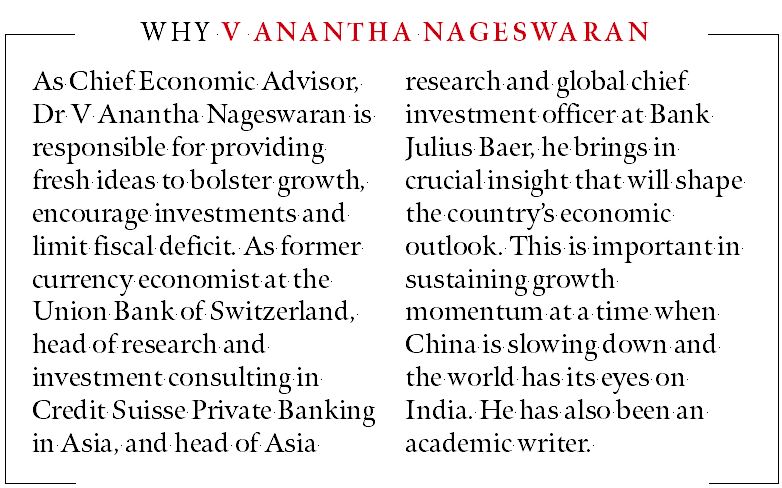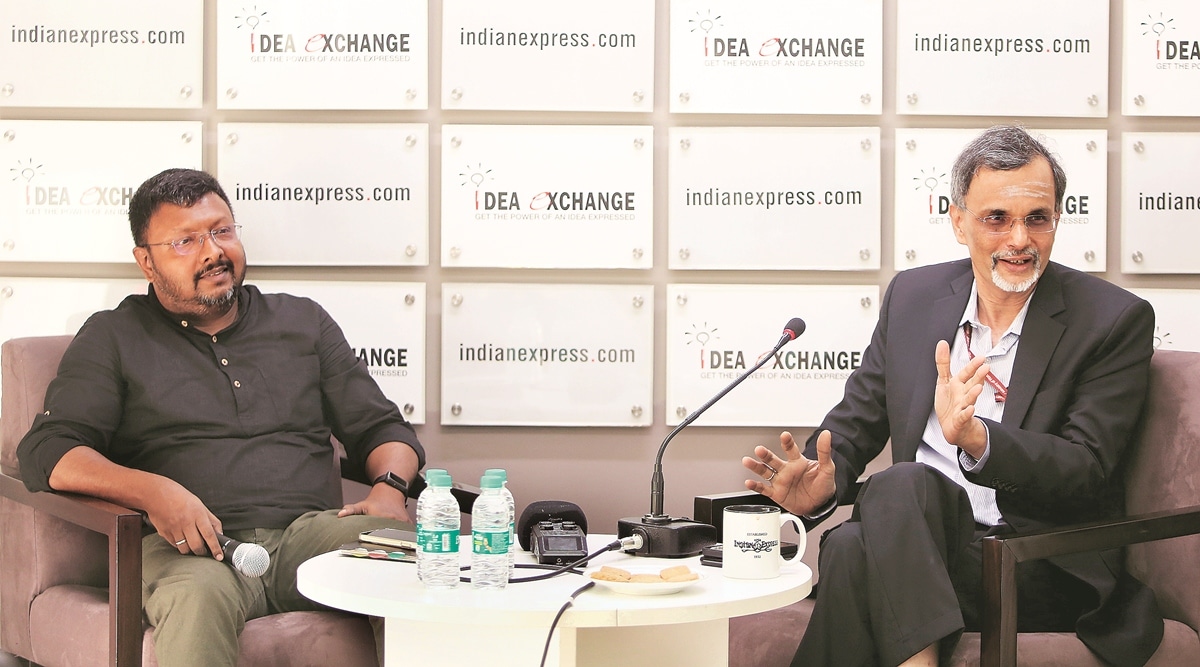CEA Anantha Nageswaran: ‘Macro-economic stability and unhindered economic activity will draw global investors’
As Chief Economic Advisor, Dr V Anantha Nageswaran is responsible for providing fresh ideas to bolster growth, encourage investments and limit fiscal deficit.
 Chief Economic Advisor V Anantha Nageswaran in conversation with Anil Sasi at the Noida office of The Indian Express. (Express photo by Gajendra Yadav)
Chief Economic Advisor V Anantha Nageswaran in conversation with Anil Sasi at the Noida office of The Indian Express. (Express photo by Gajendra Yadav) Chief Economic Advisor V Anantha Nageswaran on India’s GDP growth, the global economic slowdown, the Moody’s ratings and India’s USP to a foreign investor. The session was moderated by Anil Sasi, National Business Editor.
Anil Sasi: How do you see the economic outlook? Are there concerns about external factors and domestic issues like the erratic monsoon?
The consensus estimates vary from 7.8 to 8.5 per cent year-on-year growth for this first quarter. And we all know the reasons for it. Some of it is the deflator effect coming from the wholesale price index (WPI) and the sharp collapse of last year’s commodity price spikes. In its state of the economy report, the RBI has given a quarterly breakdown of how the GDP is going to evolve. I think we are comfortable with the 6.5 per cent estimate for real GDP growth for FY-24. As and when we revise the final numbers for FY 23, the number will be even higher than 7.2 per cent for the year ending FY March 2023. As for external concerns, the August monsoon has been disappointing but it is too early to say what kind of impact it will have on the GDP and price index. The good news is that we have adequate buffer stocks and sowing has been pretty good. And while we know that the irrigation reservoir levels are 80 per cent of last year’s, they’re also around 95 per cent of the last 10-year average. So there are some compensating factors.
Anil Sasi: In January, you had said there is a downside risk to the growth estimate. Does that position hold right now? Also there is a calibrated slowdown in Western economies. How crucial a factor is that for sustaining India’s growth momentum?
I did write in the Economic Survey that the downside risk dominated the upside surprises. But when the fourth quarter GDP came out for FY 23, I said that the risks had been evenly distributed across the central estimate of 6.5 per cent. I have slightly upgraded my sense of optimism. Private sector capital formation definitely has much more concrete signs of taking off. That’s why I’m keeping the 6.5 per cent as my central pivot with risks evenly distributed, not necessarily tilted towards the downside.

As for the global economy, there are both positives and negatives. I’m more comfortable with a slightly under-performing global economy than one that’s firing on all cylinders. I will take the beneficial side of the under-performing global economy in terms of lower commodity prices and interest rates than the export aspect of global demand. Because services sector exports are resilient. Whether the global economy is growing strongly or tepidly, you get demand from different sources for different purposes. So a slowdown in the global economy serves India better.
We have been delivering returns to investors on a risk-adjusted basis in dollar terms and if anything, that is the most important consideration for investors at the end of the day
Anil Sasi: How much of a concern is private consumption, given that it is something like 49 per cent of the overall GDP. Then there’s a continuing problem with rural demand as non-farm incomes haven’t increased.
We have factored the subdued consumption patterns. The MNREGA demand is fine, the EPFO net additions growth is also doing alright. The FMCG demand sales growth in rural India, after the small positive blip in Q4 of the last fiscal, has continued in the first quarter of FY 24 as well. And yes, two-wheeler sales are here and there. But four-wheeler sales have been picking up in both urban and semi-urban areas. So maybe there is compensation here. If we look at the first decade of the millennium, it is the private sector capital formation that led to higher investments, employment generation and income growth. The public sector has also appeared to succeed in crowding in some private sector investments. The latest RBI monthly bulletin has annual estimates of companies filing their investment plans based on their fund-raising efforts. And that is the bottom-up data as well. That is also showing a very big improvement. So I think we have both anecdotal as well as data-based evidence that private sector capital formation is no longer at the take-off stage. It has taken off.
 Chief Economic Advisor V Anantha Nageswaran in conversation with Anil Sasi at the Noida office of The Indian Express. (Express photo by Gajendra Yadav)
Chief Economic Advisor V Anantha Nageswaran in conversation with Anil Sasi at the Noida office of The Indian Express. (Express photo by Gajendra Yadav)
P Vaidyanathan Iyer: Post-GST and post pandemic, there was a lot of concern about distress in the MSME (Micro, Small and Medium Enterprises) sector. Of course, not the credit guarantees, which helped larger MSMEs. What about small and medium enterprises?
Multiple independent organisations, think tanks and consulting houses do their own surveys. Of course, you have the RBI’s bank credit growth which is disaggregated. Then we have portal registrations which show the migration of registered enterprises from a micro to small and then from small to medium. Over the last few years, there has been a small uptick in the growth of employment in factories with a workforce of over 100. These are all the multiple indicators that one tries to keep tabs on.
If we are able to grow at 6.5 to 7 per cent, undertake reforms in sectors like power generation, ensure energy security and human resource skilling, we will be elevating our growth potential
P Vaidyanathan Iyer: The government tried to bring in land and farm law reforms. How critical are these laws?
Whether they are critical or not is something that you will never be able to figure out. Because we don’t have access to the counterfactual, right? Then that is a judgement. They were considered critical because almost all political parties had included them in their manifesto before the 2019 election. So the expectation was that they would expand the choice-set to the farmers. It will be worth trying to bring them back in a different form, maybe when the climate is more propitious to do so. Since the subject matter is resting with the states squarely, reforms can also take place in a decentralised manner. The same has happened with land reforms.

Harish Damodaran: Hasn’t the Centre itself violated the spirit of the farm reforms with onion export tariffs and setting stock-holding limits?
This has always been happening because you have a broader or a clearer idea of where you want the sector to go. But, as in many countries, you have a certain philosophical commitment to a particular course of action. Different developments force you to take detours along the way.
Harish Damodaran: You said rule-based controls would come in the Essential Commodities Act, for example. But they weren’t followed for onions. If you want to attract investments in warehouses, you cannot set stock limits. Is there scope for any rule-based intervention?
I cannot answer that question. But I can’t argue against the conceptual case that you are making for predictability, transparency or more rule-based changes that may let people know when some triggers will be activated or not.
Have the investors lost confidence in those markets because of these (Hindenburg) reports? So why should you single out India for this question? The capital market regulator has responded and will be responding
Aanchal Magazine: Earlier this month, Moody’s affirmed India’s ratings and flagged political issues, especially the Manipur violence, as a matter of concern. Finance Ministry officials, before the meeting with rating agencies, had probably hoped for an upgrade. Since you were part of these meetings, was this a fair assessment?
First of all, there wasn’t any expectation. Our job is to share with them how we see the economy and the fiscal situation. While we certainly feel that our nominal GDP growth seems comfortably above the cost of borrowing, simulating the evolution of deficit and debt ratios — had we simply grown at 10 per cent per annum over the COVID-affected years instead of the actual numbers — means these debt and deficit ratios would still be several percentage points lower than what turned out to be. Therefore, the confidence remains that the evolution of debt and deficit ratios would be better than what is currently projected by many international organisations. But India’s interest payment ratio as a percentage of tax revenue is a rather high number. So we are also encouraged by the fact that despite the recent spike in advanced country bond yields, India’s 10-year treasury cost of borrowing has remained more or less the same. One way to bring down this interest payment is to make sure that your cost of capital doesn’t spike and which, of course, relies on multiple factors: fiscal management, inflation outlook and monetary policy. These are standard determining factors for the long-term cost of borrowing. We are encouraged by the fact that last year’s inflation overshoot compared to our target range was not as high as in other countries. Hopefully, it is a reflection of some supply side improvements.
And if that is the case, then we are more confident about our economic cycles lasting longer in our previous growth cycles. That will automatically feed into better fiscal ratios. We will be able to address debt burdens more meaningfully if we are able to use the asset monetisation and privatisation revenues exclusively to settle, pay off debt. Once you are divesting on the assets side, you should then use it to divert some of the liability as well. These are ways in which we will be able to get the credit rating upgrade.
 Chief Economic Advisor V Anantha Nageswaran
Chief Economic Advisor V Anantha Nageswaran
Liz Mathew: The RSS recently mentioned how the focus should be on MSMEs instead of larger industries because they generate jobs. Your take?
The government has been focussing on the MSME sector. There have been amendments to the MSME Act, raising the threshold levels, introducing the turnover criteria and giving scope for growth without losing concessions. More importantly, the mandatory rules and discounting mechanisms to help pay the MSMEs on time are conscious efforts. However, these policies are not mutually exclusive. For a country of our size, we need to pursue both size and scale-based projects, even as we support and seek to expand the MSME space.
Sukalp Sharma: On the LPG price cut, there is a sense that the government is not going to provide subsidy. There was talk about fuel price deregulation. But petrol, diesel prices have not been revised for over a year. This appears to be government interference in oil marketing companies. Your views?
It makes sense to prepare the public for normal fluctuations in commodities that they consume. But over the last two years, because of the extraordinary volatility in commodity prices, many other countries, including India, have chosen to interfere. These are compulsions that democratically elected governments cannot escape.
P Vaidyanathan Iyer: How much of the 6.5 per cent growth rate projection is firewalled from politics?
Even from the fiscal standpoint, if you look at the assumptions in the Budget, the 10.5 per cent nominal GDP growth and revenue buoyancy are assumed to be much lower than the last five-year average or 37-year average and lower than the previous financial year. So there is enough conservatism embedded in these numbers.
 Chief Economic Advisor V Anantha Nageswaran
Chief Economic Advisor V Anantha Nageswaran
P Vaidyanathan Iyer: With corporates fearing weaponisation of agencies, can it affect growth and investment?
It’s difficult to answer without knowing the specifics. Obviously, the aggrieved would always look at these things as excessive. As long as you have clear, transparent and predictable rules, people will be able to comply with them. But if there are changes and they appear to be somewhat unexpected, there will be implications. So far, there has been none.
Soumyarendra Barik: The Production Linked Incentive (PLI) scheme has worked with two mobile manufacturing companies — Apple and Samsung. But the concern is that India has one of the highest import tariffs on components. Is that a good strategy for the long-term?
The government is cognisant of these issues but this is for concerned ministries to answer. Conceptually, I agree with you that different policy aims should be consistent with each other.
Rahul Sabharwal: What do you make of Moody’s highlighting the curtailment of civil society and political dissent, compounded by sectarian tension?
We are not sure that these criteria or considerations are relevant for credit rating or the ability of governments to service their debt and repay it. These are all empirical questions and way too subjective for credit rating agencies to take them as relevant factors for the purpose of determining the ability and willingness of the government to service their obligations.
Sukalp Sharma: After Hindenburg, The Guardian and Financial Times have reported insider trading in the Adani Group. Don’t red flags like these compromise the reputation of Indian capital markets?
Don’t look at India in isolation. There were multiple issues that arose in advanced markets in the early 2000s. Whether it is accounting, auditing companies or credit rating agencies following the subprime mortgage crisis, or even more recently in the cryptocurrency space across countries, these are issues that are looked at specifically. Countries and regulators respond and adapt themselves to address them. Have you lost confidence in these markets? Have the investors lost confidence in those markets? So why should you single out India? The capital market regulator has responded and will be responding. If anything, this only strengthens the integrity of capital markets.
P Vaidyanathan Iyer: Global investors are thinking about India the way they thought about China in the 1980s. What should India do to take advantage of the sentiment?
As long as you have a transparent and stable framework, then you are going to attract both domestic and foreign investors. Your own growth prospects are the most important magnet. If there are specific transactional or procedural issues, we can fix them. But I think the attractiveness comes from the fact that you maintain macro-economic stability and allow economic activity to proceed relatively unhindered. Then, commercial returns will automatically accrue to both the direct and portfolio investors. If you look at Morgan Stanley Capital International (MSCI) indices, India’s risk-adjusted return or the Sharpe ratios have been higher than emerging market peers in dollar terms.
We have been delivering returns to investors on a risk-adjusted basis in dollar terms and if anything, that is the most important consideration for investors at the end of the day. So if we improve our ease of transacting business for all kinds of investors, the biggest magnet for investors is the return-generating opportunities that a growing Indian economy provides.
If we are able to grow at 6.5 to 7 per cent, undertake reforms in sectors like power generation, ensure energy security and human resource skilling, we are elevating our growth potential.



- 01
- 02
- 03
- 04
- 05




























